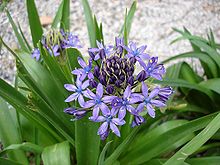- Portuguese Squill
-
Portuguese Squill 
Scientific classification 
Kingdom: Plantae clade: Angiosperms clade: Monocots Order: Asparagales Family: Asparagaceae Subfamily: Scilloideae Genus: Scilla Species: S. peruviana Binomial name Scilla peruviana
L.Portuguese Squill (Scilla peruviana) is a species of Scilla native to the western Mediterranean region in Iberia, Italy, and northwest Africa.
It is a bulb-bearing herbaceous perennial plant. The bulb is 6–8 cm diameter, white with a covering of brown scales. The leaves are linear, 20–60 cm long and 1–4 cm broad, with 5-15 leaves produced each spring. The flowering stem is 15–40 cm tall, bearing a dense pyramidal raceme of 40-100 flowers; each flower is blue, 1–2 cm diameter, with six tepals.
The scientific name peruviana, "of Peru" results from confusion over the origin of the specimens from which the species was described by Carolus Linnaeus in 1753; he was given specimens imported from Spain aboard a ship named Peru, and was misled into thinking the specimens had come from that country. The rules of botanical naming do not allow a scientific name to be changed merely because it is potentially confusing.
Cultivation and uses
It is commonly grown as an ornamental plant for its spring flowers; several cultivars are available ranging in colour from white to light or dark blue, or violet. In some areas it is also known, confusingly, as Hyacinth of Peru, Peruvian Scilla, or Cuban Lily.
Categories:- Scilloideae
Wikimedia Foundation. 2010.
